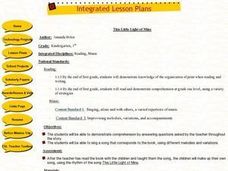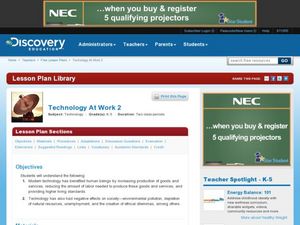Curated OER
This Little Light of Mine
Elementary schoolers discover how electricity travels and create an electron flow through a closed circuit. They work together to make a closed circuit and observe the electricity being made. This outstanding lesson plan is well worth...
Curated OER
Evidence Revealing the Composition of the Atom
Investigators use indirect evidence to guess what is occupying a sealed box. You could also use a set of plastic Easter eggs to encase the unknown items. Another terrific activity involves having students drop a pencil on a sheet of...
Teach Engineering
Understanding Elements
Nothing says organization quite like a table. The third lesson in a six-part Mixtures and Solutions unit teaches young scientists about elements and the periodic table. They learn how the periodic table is organized and about the...
Scholastic
Study Jams! Electricity
Shock your physical science class using this video to teach the basics of static electricity. Electricity is defined,and electrons are differentiated from protons on an atom model. The use of hydropower and wind are explained as ways of...
Curated OER
Electricity
Each of these slides presents the basic scientific details and situations where charge, or static may appear. Handouts of the empty PowerPoint slides could be provided so that students could work through these examples and correctly...
Curated OER
Atoms and Elements - Electron Arrangement and Periodic Law
Delve into the world of quantum mechanics by viewing this PowerPoint. Chemistry novices learn about electron energy and shells, and they practice listing electron configuration for different atoms. Because this presentation provides...
Curated OER
Flame Tests
Students perform flame tests on 12 elements. In this flame tests lesson plan, students experiment with elements to observe their visible light spectra emitted as electrons jump from one energy level to another. Students record their...
Curated OER
Atomic Models
Your students should enjoy this slideshow which includes some basic definitions about the atomic structure of atoms. In fact, this presentation would be best-viewed before giving details and diagrams of neutrons, protons and quarks. The...
Curated OER
Conductors and Insulators
Fifth graders explore conductors and insulators. In this science instructional activity, 5th graders act as electrons moving through a wire. Students break into groups representing conductors and insulators and explore how they work with...
Curated OER
Ions and Subatomic Particles
In this ions activity, students complete a graphic organizer by filling in the number of protons and electrons plus the charge of the given ion.
Curated OER
Van der Graaf
Four demonstrations with the Van der Graaf generator are delineated for you to share with your science classes. Instructions, explanations, and safety precautions are included. However, a background explanation of the static electricity...
Curated OER
Countdown Challenge
In this countdown challenge worksheet, students find the 10 common elements from the human body, earth's crust, and ancient times and color code them. Students fill the atomic number of the elements in a given periodic table.
Curated OER
Electricity
In this science worksheet, learners use the clues given at the bottom of the sheet to solve the crossword puzzle on electricity. They identify a simple device that generates electricity and a substance that allows electrons to pass...
Curated OER
Chemistry Worksheet (Mole)
In this chemistry worksheet, young scholars identify and name the number of neutrons, electrons, and protons for each. Then they illustrate how the electrons are arranged in a cloud. Students also find the relative number of atoms in the...
Curated OER
Modern Physics, Old QT
In this physics worksheet, students develop an understanding of the atomic model and how atoms relate to one another through answering the seven questions.
Curated OER
Chemistry: elements
In this chemistry learning exercise students complete a set of multiple choice and short answer questions on protons, electrons, ionization and chemical equations.
Curated OER
Applied Science - Physics Pre-Lab
Students view a static electricity demonstration. In this Physics lesson, students compare static and current electricity. Students watch an electricity slide show and sing the Electricity song.
Curated OER
Applied Science - Physics Lab
Learners explore electricity. In this Physics instructional activity, students investigate the origin of static electricity. Learners compare static electricity to current electricity.
Curated OER
Technology at Work 2
Students discover the positive and negative effects of technology. In this technology lesson, students give examples of technology advances from the past few years. Students get into groups and debate whether a particular item has hurt...
Curated OER
Static Electricity
In this static electricity activity, students experiment with balloons, plastic bags and flannel clothes to observe attraction and repulsion of objects. Students complete three data tables indicating the charge on the objects and if they...
Curated OER
Interactive Notes-"Electricity"
Students explore electricity. In this interactive electricity lesson, students create static electricity with balloons, observe the rate at which ice melts to identify conductors and insulators, and create a static charge. ...
Curated OER
The Electron "Do"
In this electron worksheet, students experiment with a balloon and their lab partner's hair. They determine if hair or the balloon releases electrons and they also determine which type of hair transfers electrons the best.
Curated OER
What Do Atoms Look Like?
In this atomic structure activity, students answer eleven short answer questions about the structure of atoms including the number of protons, neutrons and electrons. Students indicate the differences in isotopes of atoms and what the...
Curated OER
Mass Spectrometer
For this mass spectrometer worksheet, students read about how a mass spectrometer determines the elements in gases around Earth. Students answer 3 questions and identify the elements in a graph found by a mass spectrometer.

























